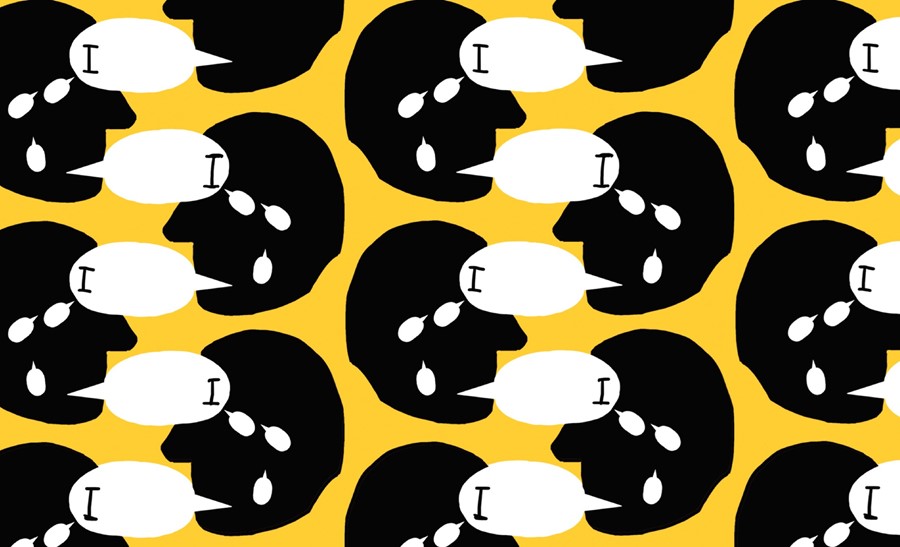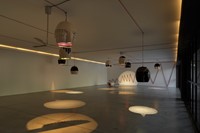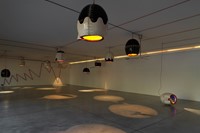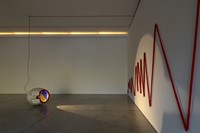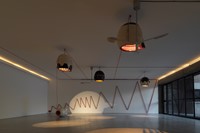Max Mara art prize winner Emma Hart talks us through her vivid interpretation of a family tree
English artist Emma Hart is fascinated by family dynamics and patterns. Her most recent installation work, playfully titled Mamma Mia!, is an artist’s interpretation of a family tree; several head-shaped ceramic jugs hang upside down in a dark gallery space, each piece connected by a red rope. Inside each jug is a brightly lit unique pattern that represents a different state of mind: jealousy, paranoia, grief, or sexual desire. Projected on the floor are speech bubbles, suggesting an animated conversation between this family of interconnected ceramics. Rotating ceiling fans interrupt the conversation and add a feeling of dynamism to the room. Psychological concepts – establishing patterns of thought, projection and discussion, analysing family dynamics – are central to experiencing Hart’s thoughtful new work.
Deeply influenced by psychological studies – and traditional Italian ceramic design – Mamma Mia! is the fascinating result of Hart’s six month residency in Italy. Having won the prestigious Max Mara Art Prize for Women, the artist was able to visit Milan, Rome, Todi, and Faenza to research and create her new installation. After seeing the work at the Collezione Maramotti in Italy, we had a chance to chat with the artist about her creative process and research into family psychology.
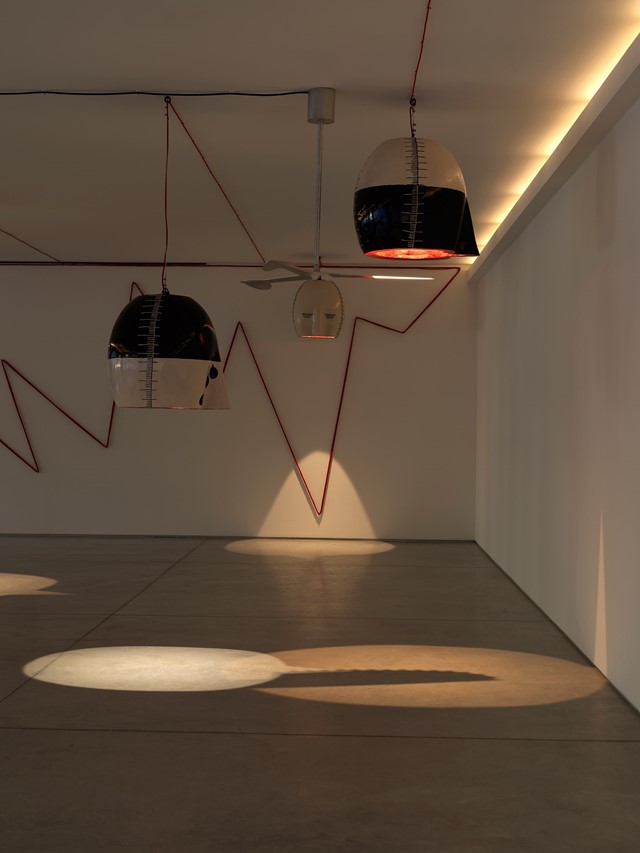
On studying family psychology…
“In Italy, I spent time researching the work of Mara Selvini Palazzoli, a family psychologist in Milan. She was a kind of radical maverick who studied the way families become stuck in their habits and create of feedback loops of behaviour. She spent a lot of time thinking about how to break families out of those, and insisted on always seeing a group or a family of people. She understood that the individual never got unwell, it was only the space between people that became unwell. As an artist who tries to think about how artwork makes relationships with its viewer, some of her ideas were very interesting to me.
“A lot of my work is about the difference between the inside and the outside – the struggle between the public and the private. And I think it’s probably what psychology is, really – a struggle between public and private personas. They never sit in harmony. It’s always difficult. The jug is a useful way to think about insides and outsides and a jug is full, or empty, or different levels of stuff going on in your head. That’s all kind of references from psychology. The jug is a mouth, and spout, and you pour out stuff, and maybe that’s a bit like what happens when you see psychologist – this outpouring happens.”

On learning about ceramics and traditional Italian maiolica techniques...
“I spent the second part of my residency in Faenza, the capital of maiolica ceramics, so I could learn about glazing and decorating. I learned that in 16th century, if you got married, you had to have a plate to commemorate the wedding. If you didn’t have a plate, it was almost viewed as if the marriage wasn’t official. The ceramics not only commemorate family relationships, but also kind of make them happen as well. Powerful families would also gift ceramics to other powerful families as a political move to establish friendships and form alliances. And then of course, people also eat off ceramics at the dinner table, and families use them all the time.
“I’d just come from the psychology clinic, where I had been learning a new vocabulary to speak about human behaviour. They used words like repeat, impregnate and switch to describe the way we behave with one another, especially in the family. When I left and went to Todi to learn from master craftspeople there, they described their strategies for creating patterns with words like research, impregnate, and switching a design, and I thought, wait a second, I’ve heard this language before! I realised that there could potentially be a link between trying to capture a pattern of human behaviour, and trying to make a visual decoration or design. The individual patterns inside the jugs all describe different states of mind, like jealousy, paranoia, or grief.”

On creating a neural network…
“The red line connecting the ceramic jugs is actually a power cable. It references a genogram, a kind of mapping tool I’d been shown in the Milan clinic. Genograms which were like family trees, but instead of just thin lines, they had different colour lines that indicate what type of relationship it is. So, say that the mother was related to the daughter, but if that line was red and zigzag it means that the mother and daughter were hostile. If that line is green, I think that meant they got on well. They had these very detailed diagrams about how the relationships all work in the family, and that's what the red and the zigzag power lines kind of are referencing.
“I think we’re all kind of stuck in a system. When the viewer walks under one of the hanging jugs, they enter into a network, or their system, by stepping into the light. It’s a kind of play on the word ‘projection’. I’m using light as a way to touch, infect, or even corrupt the viewer. As you explore these different interior worlds, they shout at you, or they bring you into their thoughts, or speech bubble. And if you don’t do that, if you don’t look inside these ‘heads’, you don’t get the reward, which is to see the colourful pattern inside. I think that the heads are some kind of strange family all linked by the power cable, with all different things going on in their minds.”
Emma Hart, Mamma Mia! runs until February 18, 2017 at Collezione Maramotti, Italy.
